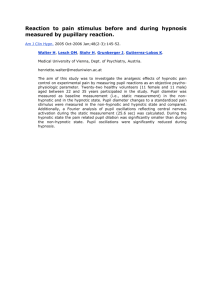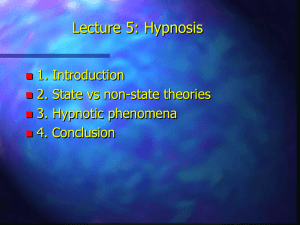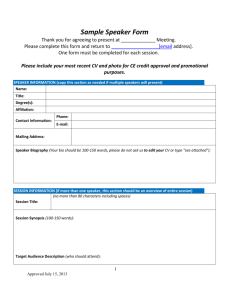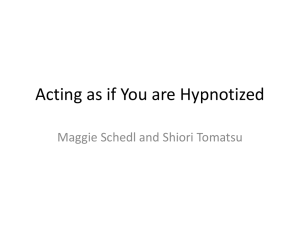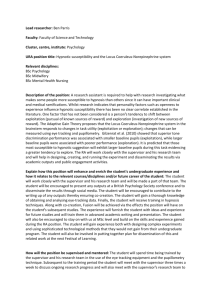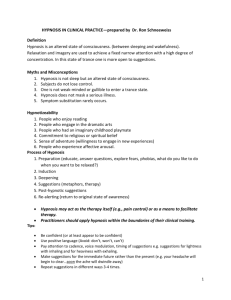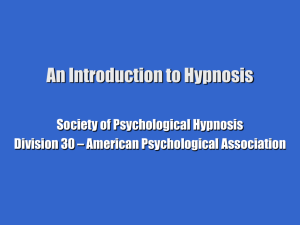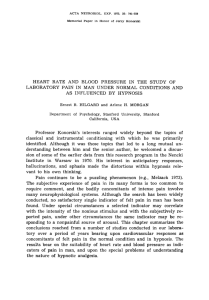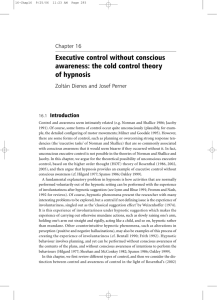Hypnosis
advertisement
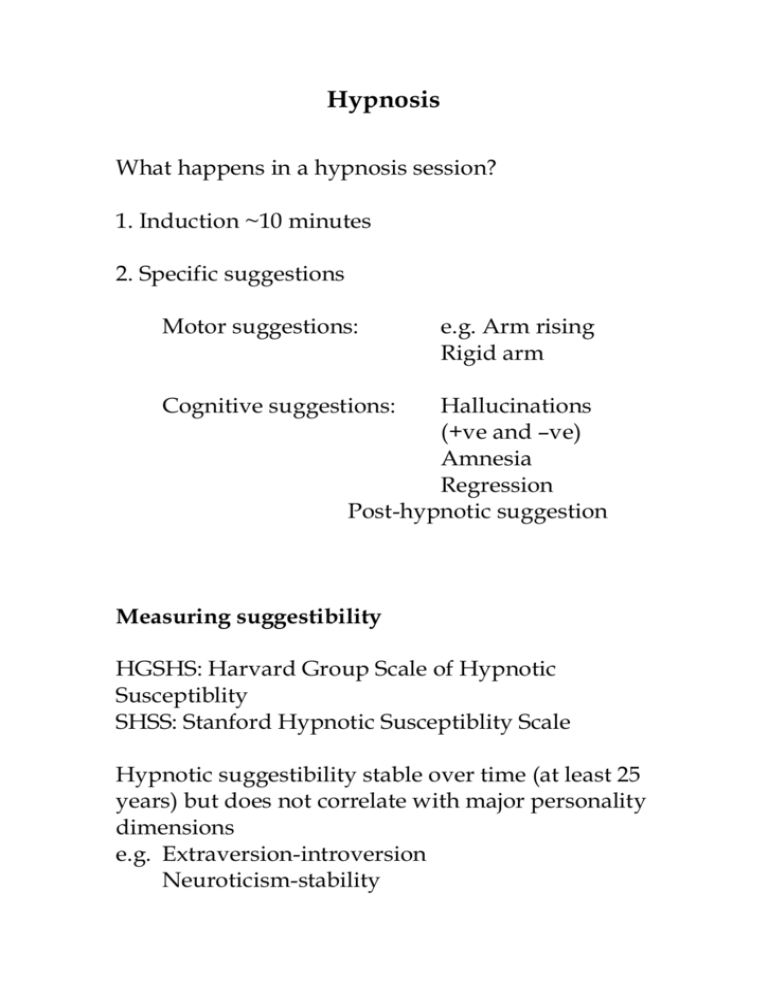
Hypnosis What happens in a hypnosis session? 1. Induction ~10 minutes 2. Specific suggestions Motor suggestions: e.g. Arm rising Rigid arm Cognitive suggestions: Hallucinations (+ve and –ve) Amnesia Regression Post-hypnotic suggestion Measuring suggestibility HGSHS: Harvard Group Scale of Hypnotic Susceptiblity SHSS: Stanford Hypnotic Susceptiblity Scale Hypnotic suggestibility stable over time (at least 25 years) but does not correlate with major personality dimensions e.g. Extraversion-introversion Neuroticism-stability Theories of hypnosis: 1. Socio-cognitive theory (Spanos, 1970s, 1980s) Social psychology tells us: Social context affects us more than we typically believe it will. So we attribute the effect to something else. Hypnosis is a social influence situation in which we attribute our actions to hypnosis - not the social demands per se or even ourselves. => hence the feeling of involuntariness. => There is no special state of hypnosis, nor any special process involved in hypnotic responding. Subjects simply perform as they believe a good subject should perform. Prediction: Social demands should have a large effect on how hypnotised subjects respond. (NB: Does not necessarily mean subjects are just complying) 2. (Neo-) Dissociation theory (Hilgard, 1970’s, 1980s) The mind consists of a hierarchy of control structures: Hypnosis dissociates the Executive Ego, so that part of it is under direct control of hypnotic instructions: There should be part of the person aware of everything that is happening. Hilgard demonstrated the “Hidden Observer”: During hypnotic analgesia subjects rates very little pain as arm is held in ice cold water. “There is a hidden part of you that really knows everything that is going on. When I put my hand on your shoulder, I can contact this hidden part” The hidden observer gives high pain ratings, and insists they have always been high; when the hand is off the shoulder the person gives low pain ratings! Artifact or suggestion? Prediction: There should be hypnotic effects independent of social demands. (NB: According to Hilgard, hypnosis need not be an altered state of consciousness – though one could call it that if there were enough cognitive structures under dissociated control) 3. Dissociated Control theory (Woody & Bowers, e.g. 1994) How can the production of very common hypnotic responses (e.g. motor suggestions, which lows respond to) be produced by a very rare phenomenon (amnesia, the hidden observer, which only about half of highs show)? Hypnotic induction weakens Executive Ego (a state theory!) so that the control structures are directly affected by hypnotic suggestions. 4. Socio-cognitive theory of Kirsch & Lynn (1997) No evidence for there being a distinct state of hypnosis; hypnotic induction increases responsiveness by only a small amount (that can be explained by expectation). Subjects: Intend that their cognitive control structures will be triggered by the hypnotist’s suggestions. After this intention is formed, executive ego need not be involved. Feelings of volition in general are just interpretations and attributions. When control structures are triggered by hypnotist, the effects are attributed as involuntary, in line with expectations. 5. Ideomotor theory (recently: Baars, 1988) Actions are automatically caused by maintaining an appropriate image of them. See last seminar paper for falsifying evidence. Orne (1959) The real-simulator design Simulators are lows (low susceptiblity subjects) asked to fool the hypnotist into believing they are highs. Simulators behaviour = demand characteristics Reals behaviour = demand characteristics + genuine hypnotic effects. Will hypnotized subjects perform dangerous or anti-social acts? Orne & Evans (1965) Hypnotized subjects asked to: - Put the hand in a box with a red-bellied black snake - throw nitric acid in the face of a research assistant 5 out of 6 subjects did so. But so did 6 out of 6 simulators Coe et al (1973) 26 highs selected. Told: “In the future when I tell you that now you are hypnotized, you will be hypnotized” An arrangement is made to meet E by the library. At the library, subjects are asked to help sell heroin – drive to an apartment, say code word, deliver the bags, collect $100 to give to E. For half the subjects these instructions were given under hypnosis and subjects were told they would forget what they had done. 9 subjects went through with the crime: 3/12 from the hypnosis condition BUT 6/14 from the condition without hypnosis Whether they went through with the crime or not strongly depended on their prior reports of how much the act conflicted with their moral values. Compliance? Kirsch et al (1989) The surreptitious observation design. Subjects played a tape of hypnotic suggestions while being watched by an experimenter or “alone”. Experimenter Absent Present Simulators <-------------------------------> Were different levels of demand created? Reals <-------------------------------> Did reals comply with these demands? Experimenter Absent Present Simulators 2.7 8.7 Reals 9.6 9.8 Reals NOT just complying! Is the nature of hypnotic involuntariness responsive to demand characteristics? Lynn et al (1984) Subjects given a lecture on hypnosis. “move” subjects told: A good hypnotic subject will NOT be able to resist a suggestion when requested to try to resist “resist” subjects told: A good hypnotic subject WILL be able to resist a suggestion when requested to try to resist. Subjects given 5 motor suggestions and asked to resist. Amount of movement rated on a 3 point scale. 15 14 13 12 11 10 9 8 7 6 5 move GROUP resist => Ability to resist depends on belief and expectations. Will post-hypnotic responding occur automatically, regardless of its appropriateness? Orne et al 1968 Reals but not simulators responded to cue given by secretary. Spanos et al 1987 - simulators asked to fool everyone connected with experiment. - Subjects told post-hypnotic suggestion would last for two days - Informal experimenter test given (high social demands) - Two confederates intercepted subjects on campus (low social demands) and gave cue word (“experiment”) Passed/10 Reals Sims Formal test Informal Confed. 10 10 4 6 0 1 => behaviour not elicited out of context


